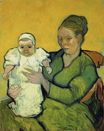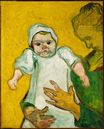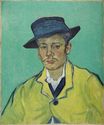Винсент Ван Гог - Мамаша Рулен с младенцем 1888
 |
 |
 |
 |
 |
 |
 |

Мамаша Рулен с младенцем 1888
92x73см холст/масло
Philadelphia, The Philadelphia Museum of Art
<< Previous G a l l e r y Next >>
From Masterpieces from the Philadelphia Museum of Art:
Impressionism and Modern Art
In early December 1888, Vincent van Gogh wrote to his brother Theo from Arles where he was staying: "I have made portraits of a whole family, that of the postman whose head I had done previously, the man, his wife, the baby, the little boy, and the son of sixteen, all characters and very French."1 Not content with his initial portraits of the family, van Gogh continued to paint them, producing several pictures of Madame Roulin, the postman's wife. In two of them, including this one, she holds the couple's daughter, Marcelle, born in July 1888. With a relaxed pose and her face in shadow, Madame Roulin is a passive figure, while the baby, whose chubby face looks outward to engage us directly, is the more active and central subject. Van Gogh's work with color is one of the most dramatic aspects of the series; each family member is distinguished by bold primary colors in their clothing and contrasting backgrounds that correspond to different points on a color wheel. Here, the figures are painted in shades of green and white with blue outlines and a yellow ground. The use of these three colors, adjacent on the color wheel, underlines the closeness of mother and child.
Jennifer A. Thompson, from Masterpieces from the Philadelphia Museum of Art: Impressionism and Modern Art (2007), p. 90.